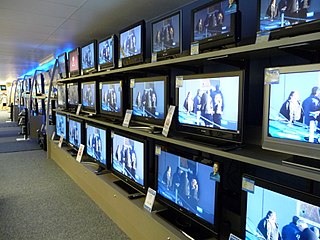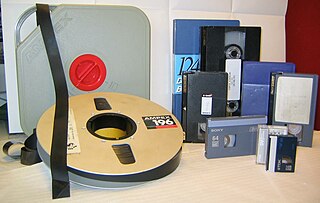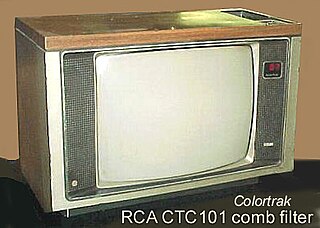Related Research Articles
The RCA Corporation was a major American electronics company, which was founded in 1919 as the Radio Corporation of America. It was initially a patent trust owned by General Electric (GE), Westinghouse, AT&T Corporation and United Fruit Company. In 1932, RCA became an independent company after the partners were required to divest their ownership as part of the settlement of a government antitrust suit.

Television (TV) is a telecommunication medium for transmitting moving images and sound. The term can refer to a television set, or the medium of television transmission. Television is a mass medium for advertising, entertainment, news, and sports.

In electronics, a remote control is an electronic device used to operate another device from a distance, usually wirelessly. In consumer electronics, a remote control can be used to operate devices such as a television set, DVD player or other digital home media appliance. A remote control can allow operation of devices that are out of convenient reach for direct operation of controls. They function best when used from a short distance. This is primarily a convenience feature for the user. In some cases, remote controls allow a person to operate a device that they otherwise would not be able to reach, as when a garage door opener is triggered from outside.

Videotape is magnetic tape used for storing video and usually sound in addition. Information stored can be in the form of either an analog or digital signal. Videotape is used in both video tape recorders (VTRs) and, more commonly, videocassette recorders (VCRs) and camcorders. Videotapes have also been used for storing scientific or medical data, such as the data produced by an electrocardiogram.

Composite video is an analog video format that typically carries a 525 or 625 line signal on a single channel, unlike the higher-quality S-Video and the even higher-quality component video.
A DVD player is a device that plays DVDs produced under both the DVD-Video and DVD-Audio technical standards, two different and incompatible standards. Some DVD players will also play audio CDs. DVD players are connected to a television to watch the DVD content, which could be a movie, a recorded TV show, or other content.

Component video is an analog video signal that has been split into two or more component channels. In popular use, it refers to a type of component analog video (CAV) information that is transmitted or stored as three separate signals. Component video can be contrasted with composite video in which all the video information is combined into a single signal that is used in analog television. Like composite, component cables do not carry audio and are often paired with audio cables.

A camcorder is a self-contained portable electronic device with video and recording as its primary function. It is typically equipped with an articulating screen mounted on the left side, a belt to facilitate holding on the right side, hot-swappable battery facing towards the user, hot-swappable recording media, and an internally contained quiet optical zoom lens.

A professional video camera is a high-end device for creating electronic moving images. Originally developed for use in television studios or with outside broadcast trucks, they are now also used for music videos, direct-to-video movies, corporate and educational videos, wedding videos, among other uses. Since the 2000s, most professional video cameras are digital professional video cameras.
A television set or television receiver is an electronic device for the purpose of viewing and hearing television broadcasts, or as a computer monitor. It combines a tuner, display, and loudspeakers. Introduced in the late 1920s in mechanical form, television sets became a popular consumer product after World War II in electronic form, using cathode ray tube (CRT) technology. The addition of color to broadcast television after 1953 further increased the popularity of television sets in the 1960s, and an outdoor antenna became a common feature of suburban homes. The ubiquitous television set became the display device for the first recorded media for consumer use in the 1970s, such as Betamax, VHS; these were later succeeded by DVD. It has been used as a display device since the first generation of home computers and dedicated video game consoles in the 1980s. By the early 2010s, flat-panel television incorporating liquid-crystal display (LCD) technology, especially LED-backlit LCD technology, largely replaced CRT and other display technologies. Modern flat panel TVs are typically capable of high-definition display and can also play content from a USB device. Starting in the late 2010s, most flat panel TVs began to offer 4K and 8K resolutions.
Zenith Electronics, LLC, is an American research and development company that develops ATSC and digital rights management technologies. It is owned by the South Korean company LG Electronics. Zenith was previously an American brand of consumer electronics, a manufacturer of radio and television receivers and other consumer electronics, and was headquartered in Glenview, Illinois. After a series of layoffs, the consolidated headquarters moved to Lincolnshire, Illinois. For many years, their famous slogan was "The quality goes in before the name goes on". LG Electronics acquired a controlling share of Zenith in 1995; Zenith became a wholly owned subsidiary in 1999. Zenith was the inventor of subscription television and the modern remote control, and was the first to develop high-definition television (HDTV) in North America.

Colortrak was a trademark used on several RCA color televisions beginning in the 1970s and lasting into the 1990s. After RCA was acquired by General Electric in 1986, GE began marketing sets identical to those from RCA. GE sold both RCA and GE consumer electronics lines to Thomson SA in 1988. RCA televisions with the Colortrak branding were mid-range models; positioned above the low-end XL-100 series but below the high-end Dimensia and Colortrak 2000 series. RCA discontinued the Colortrak name in the late 1990s, with newer models badged as the Entertainment Series.

1–inch type B VTR is a reel-to-reel analog recording video tape format developed by the Bosch Fernseh division of Bosch in Germany in 1976. The magnetic tape format became the broadcasting standard in continental Europe, but adoption was limited in the United States and United Kingdom, where the Type C videotape VTR met with greater success.

2-inch quadruplex videotape was the first practical and commercially successful analog recording video tape format. It was developed and released for the broadcast television industry in 1956 by Ampex, an American company based in Redwood City, California. The first videotape recorder using this format was built the same year. This format revolutionized broadcast television operations and television production, since the only recording medium available to the TV industry until then was kinescope film.
The RCA Lyceum TV was a commercial monitor/receiver with a large input/output panel on the back, and a 20-foot (6.1 m) long grounded plug. During the mid-80s, RCA released the Colortrak 2000, a television identical to the Dimensia table-top model. Even though the Colortrak was considered the mid-range model, those bearing the name Colortrak 2000, were considered high-end, along with the Dimensia. The Lyceum TV, Dimensia, and Colortrak 2000 models all basically had the same chassis.
ProScan is a consumer electronics manufacturer and has a trademark in continuous use since 1990. It is one brand of the French company Technicolor SA with products competing with higher-end electronics. The ProScan name is owned by Technicolor USA, Inc. The company created television and video products to compete with Sony's Trinitron XBR, Pioneer's Elite, and other electronics brand lines. Competition is focused mainly on price to size ratio. The tagline for ProScan is "So advanced, yet so simple."

The XL-100 was a line of RCA solid-state television sets introduced in 1971. The "XL" stands for extended life chassis while the 100 refers to RCA's emphasis of 100% solid-state chassis. Initially the top-of-the-line RCA color televisions, they would become lower-end as the Colortrak and Dimensia series were introduced The original models replaced the RCA "Vista" and "New Vista" color television series. The XL 100 name was discontinued in the late 1990s.
Dimensia was RCA's brand name for their high-end models of television systems and their components produced from 1984 to 1989, with variations continuing into the early 1990s, superseded by the ProScan model line. After RCA was acquired by General Electric in 1986, GE sold the RCA consumer electronics line to Thomson SA which continued the Dimensia line. They are significant for their wide array of advanced features and for being the first television receiver systems to feature a built in computer, somewhat of an early incarnation of a smart TV, but without internet access. In 1985, RCA released the Digital Command Component System, a fully integrated audio system that permitted the full functionality of Dimensia audio components without a Dimensia monitor. The name "Dimensia" actually dates back to the early 1970s when RCA used the term for an enhanced spatial stereo effect which they called "Dimensia IV". The tagline for the Dimensia was The Next Dimension in Sight and Sound.

The Digital Command Center was a very large remote control introduced for RCA's high-end television sets; in 1983 for the Colortrak 2000 and the SJT400 CED player and in 1984 for the Dimensia Lyceum TV sets. The main feature of the Digital Command Center was that it was universal amongst many RCA components, including VCRs, CED players, tuners, amplifiers, CD players, etc., on top of controlling the monitor itself. The Digital Command Center took four AA batteries to power, due to its extensive and ahead-of-its time functionality.
Audio connectors and video connectors are electrical or optical connectors for carrying audio or video signals. Audio interfaces or video interfaces define physical parameters and interpretation of signals. For digital audio and digital video, this can be thought of as defining the physical layer, data link layer, and most or all of the application layer. For analog audio and analog video these functions are all represented in a single signal specification like NTSC or the direct speaker-driving signal of analog audio.